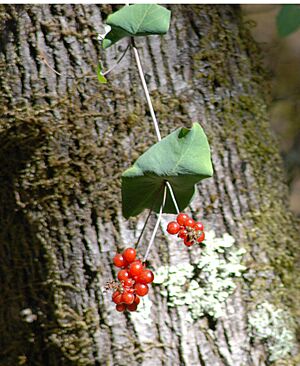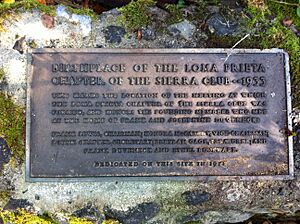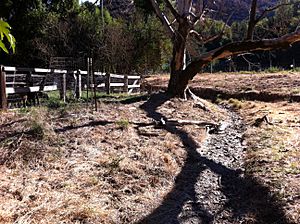Hidden Villa facts for kids
| Type | Non-governmental organization |
|---|---|
| Location |
|
Hidden Villa is a special place in the United States. It's a non-profit organization that teaches kids and adults about nature, the environment, and different cultures. It was started in 1924 by Frank and Josephine Duveneck. They created this working organic farm and wild area on the foothills of Black Mountain in Los Altos Hills, California. This land is part of the Santa Cruz Mountains. Hidden Villa is important because it was the first American youth hostel in the West. It also had the nation's first summer camp for children from many different backgrounds.
Contents
History of Hidden Villa
The land where Hidden Villa is located was once part of a large land grant. This grant was given in 1840 to José Gorgonio and his son José Ramon. They were Ohlone Native Americans from Mission Santa Clara.
In 1867, George Washington Moody built Moody Road. This road went through what is now Hidden Villa. Moody was a farmer, and his home eventually became Hidden Villa Ranch.
Later, in 1887, Otto Arnold bought over 600 acres of Hidden Villa. After his wife passed away in 1904, Captain George Ewing owned the land.
The Duveneck Family's Vision
Frank Boott Duveneck and his wife Josephine bought 1,400 acres of Hidden Villa in 1923. They paid $10 in gold and took over a $20,000 mortgage. The Duvenecks fixed up the White House at Hidden Villa. This building was built in the 1860s as a stop for stagecoaches. It was known as the Halfway House because it was halfway between San Jose and Pescadero. In 1930, the Duvenecks built their main home on a nearby hill.
Frank Duveneck helped start the Loma Prieta Chapter of the Sierra Club in 1933. This was the fourth chapter of the club. A special marker on the Creek Trail shows where it began. Frank and Josephine also helped start Friends Outside. This group supports prisoners and their families. The Duvenecks also gave a safe place for Japanese-Americans returning from special camps. They also helped César Chávez when he was organizing farm workers in the 1950s.
In 1937, Frank and Josephine Duveneck opened the first American youth hostel in the western United States at Hidden Villa. Since 1945, the nation's first summer camp for children from different cultures has been held there. Hidden Villa became a non-profit organization in 1960. Its Environmental Education Program started in 1970.
Protecting the Land
The entire Duveneck family gave Hidden Villa to the public after Frank passed away in 1985. They really wanted to protect the water source of Adobe Creek. They bought more land to keep the whole upper part of the creek clean. This made Hidden Villa grow to 1,600 acres. It became one of the few untouched water areas in the Bay Area. By 1982, most of the land was protected. This made sure the Duvenecks' wish came true. Josephine Duveneck wrote in her book, Life on Two Levels, that their family agreed to dedicate a large part of the wild area, including the creek, for public use as a permanent wildlife sanctuary.
Educational Programs at Hidden Villa
Hidden Villa offers many educational programs. These include learning about the environment and summer camps. They have both day camps and overnight camps. They also offer community programs about being sustainable, caring for animals, and nature. Their community supported agriculture program provides fresh, organic food to local communities. About 30,000 people attend these programs each year.
Even if you don't join a formal program, you can visit the farm. You can see the farm animals, explore the gardens, or hike on the 8 miles (13 km) of trails.
Hiking and Trails
Hidden Villa is surrounded by open spaces like Monte Bello Open Space Preserve and Rancho San Antonio Open Space Preserve. The farm and hostel are in a valley about 500 feet (152 m) above sea level. The "Creek Trail" is an easy 2-mile (3.2 km) hike along the east fork of Adobe Creek. The creek still flows all year in this wooded area.
You can reach the Black Mountain Trail from Hidden Villa. The Black Mountain Trail is at Ewing Hill, about 1,200 feet (366 m) high. You can take the Hostel Trail (1.3 miles or 2.1 km) or the Creek Trail (1 mile or 1.6 km) which connects to the Ewing Trail (0.3 miles or 0.5 km). The Black Mountain Trail then goes up a steep 3 miles (4.8 km) to the 2,800-foot (853 m) summit of Black Mountain.
Nature and Wildlife
Steelhead trout used to live in Adobe Creek a long time ago. People reported seeing them in 1877 and 1898. The parts of the creek upstream from Hidden Villa were considered excellent places for trout. A local historian also said that the creeks joining Adobe Creek were "originally full of fish."
Adobe Creek used to flow all year round. Steelhead trout babies need to spend their first year in fresh water. They cannot survive in streams that dry up. There were even lawsuits in the past to stop people from taking water from the creek for farming. This was because it made the creek dry up in certain seasons. This shows that Adobe Creek used to flow year-round. A brochure from 1909 even advertised Los Altos for its "never-failing mountain trout stream."
The California Native Plant Society has a special nursery at Hidden Villa. They grow native plants there. They also hold two plant sales every year, in April and October.






